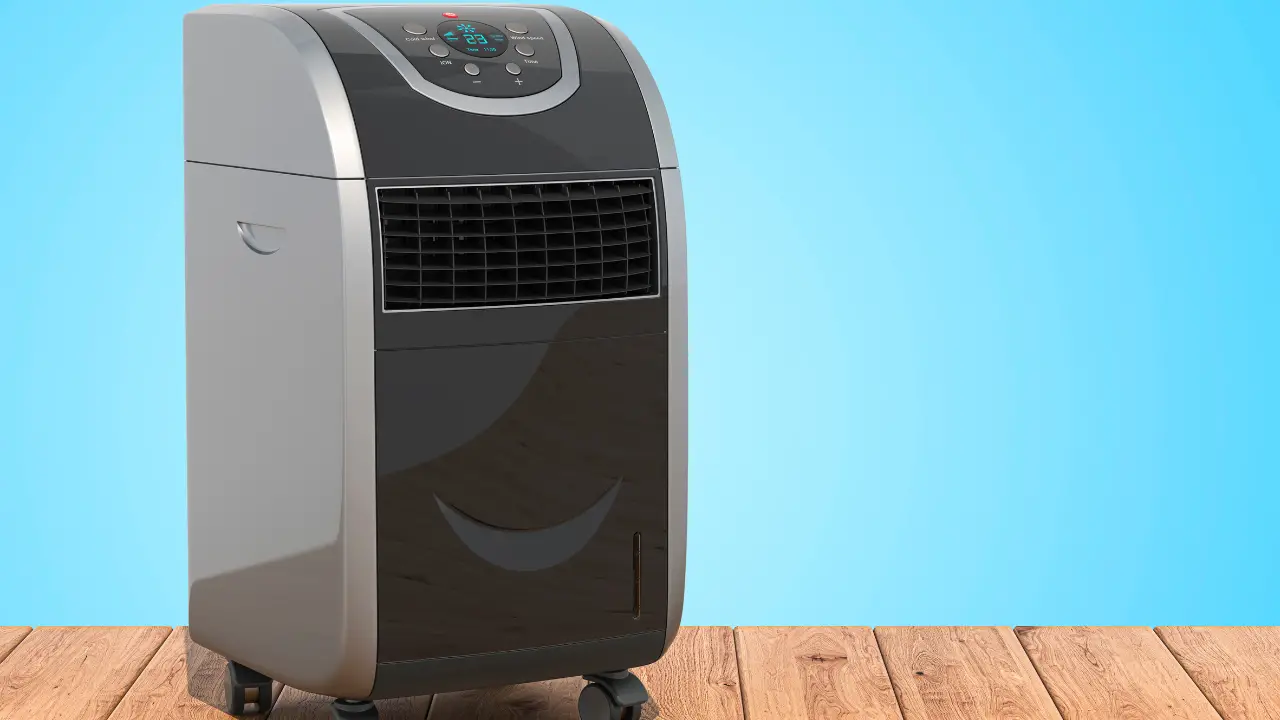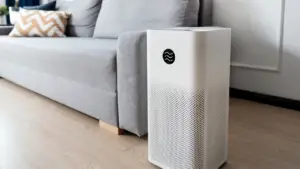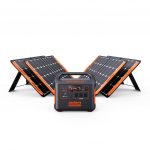Camping is a great way to enjoy the outdoors and escape the hustle and bustle of daily life. However, camping can become uncomfortable during hot summer months without proper Ventilation; This is where portable air conditioners come in. This guide will discuss everything you need to know about portable air conditioners for tents, including their benefits, features, and top picks.
Table of Contents
Importance of temperature control in tents
Temperature control is crucial when creating a comfortable and enjoyable environment inside a tent. Whether camping during the scorching summer months or facing chilly nights in colder climates, maintaining an optimal temperature can significantly enhance your camping experience. Here are several reasons why temperature control is essential in tents:
Comfort and well-being:
Extreme temperatures can make tent camping unbearable. Excessive heat can lead to discomfort, excessive sweating, and dehydration, while cold temperatures can cause shivering, numbness, and even hypothermia. By regulating the temperature inside the tent, you can create a cozy and comfortable space that promotes relaxation and well-being.
Health and safety:
Temperature extremes can adversely affect your health and safety. Heat exhaustion and heatstroke are serious risks in hot weather, especially if the tent lacks proper Ventilation. On the other hand, exposure to extremely low temperatures can lead to frostbite and other cold-related injuries. Maintaining an appropriate temperature helps mitigate these health risks and ensures your camping safety.
Improved sleep quality:
Quality sleep is essential for an enjoyable camping trip. Extreme temperatures can disrupt sleep patterns, making it difficult to rest and rejuvenate. Using a portable air conditioner or other cooling solutions, you can create a comfortable sleeping environment and ensure a good night’s sleep. You will wake up refreshed and ready for the day’s adventures.
Preserving perishable items:
If you carry perishable food or medications requiring specific temperature conditions, maintaining a controlled temperature inside the tent becomes even more critical. High temperatures can spoil food quickly, while low temperatures can freeze medications or other temperature-sensitive items. With proper temperature control, you can safeguard your supplies and prevent unnecessary waste or spoilage.
Enhanced outdoor experience:
Camping is all about enjoying the great outdoors, but extreme temperatures can hinder your ability to explore and engage in outdoor activities. By regulating the temperature inside your tent, you create a comfortable refuge where you can retreat and recharge between your adventures. It allows you to fully immerse yourself in nature while having a comfortable place to rest and recover.
Best buy air conditioners
Ovolta 1400ml evaporative portable air conditioner
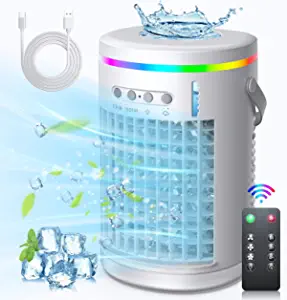
The Ovolta Portable Air Conditioner is a fast-cooling device that effectively cools hot dry air in just 5 seconds when filled with ice water or ice cubes. It can serve multiple functions, acting as a night light, desk fan, and cool-mist humidifier, making it ideal for enjoying a cool summer.
It features a large 1400ml water tank that can last for 8-10 hours, minimizing the need for frequent water or ice additions. The water level window design allows for easy water control, and it includes a water storage tank at the bottom to prevent water leakage.
Equipped with dual ultrasonic atomizers and wet triple refrigeration, the Ovolta Portable Air Conditioner transforms hot dry air into cool, fresh air. It also offers a mist sprayer function, with two modes for continuous or intermittent spray. The atomizers are efficient enough to allow the addition of perfume or essential oils to the water tank.
The Ovolta unit offers three adjustable wind speeds (Low, Medium, High) and a timer function (1H, 2H, 4H) for added convenience. The unit is user-friendly, coming with a remote control for easy operation from a distance, and it’s designed with a handle for easy portability.
Portable air conditioners, 4 speed USB powered personal air cooler
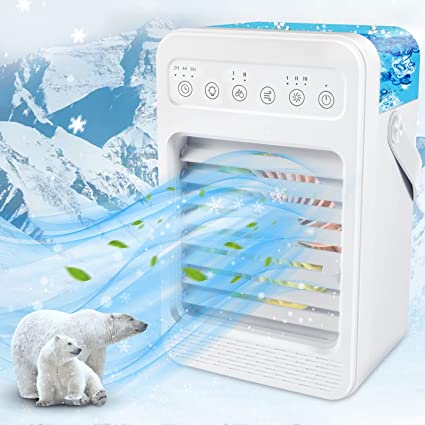
This portable air conditioner offers four wind speeds and two humidifier modes, allowing you to customize the device to suit your comfort needs. Whether you require medium wind at work or a gentle breeze for sleep, it caters to your preferences.
It features a 20 oz top-filled water tank, offering up to 8 hours of humidification on the first fog setting and 6 hours on the second. The tank reduces the need for frequent refills and can be enhanced with cold water or ice cubes for a more refreshing experience. The device is also equipped with a drip tray at the bottom that’s easy to clean and replace, preventing water leakage. When the water runs out, a water shortage protection function will activate, switching the device to natural wind mode.
The portable air conditioner operates silently, with a maximum wind speed reaching just 45dB. It also has three optional timers (2, 4, and 6 hours), preventing discomfort from prolonged cold air and helping to conserve energy.
MEATSONO portable air conditioners
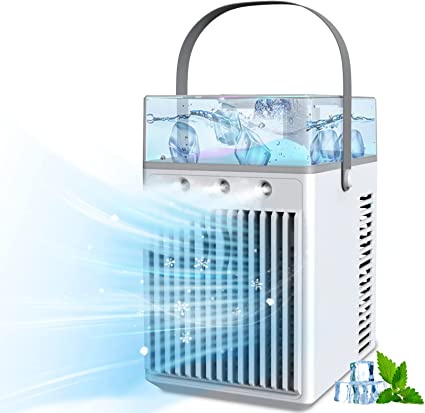
The latest in air cooler technology, this device uses a unique ice box cooling design that rapidly reduces temperature. You freeze the ice crystal box after injecting water, and it swiftly absorbs heat from the surrounding area to decrease the temperature. Six ice boxes can be used interchangeably for continuous cooling.
This mini air cooler is highly versatile, functioning as a desktop fan, humidifier, and LED light, with the ability to use these functions together or separately. It can be a fan in the summer, a humidifier in winter, and a soothing LED light during sleep, offering year-round utility.
Equipped with three atomizer holes, the device emits a refreshing mist that cools the air and reduces dryness and static, making your living environment more comfortable.
The air cooler features a unique iceberg design with a large 730mL water tank. Coupled with a three-level brightness LED light, it creates a tranquil, soothing environment, making it an excellent night light.
Compact and portable, this air cooler can accompany you to the kitchen, bedroom, office, camping trips, picnics, and more. It comes with a built-in 2000mAh large-capacity rechargeable battery and a Type-C cable (no adapter included), making it easy to carry and use wherever you need it.
LEAEYFE cooling fan mini air conditioner
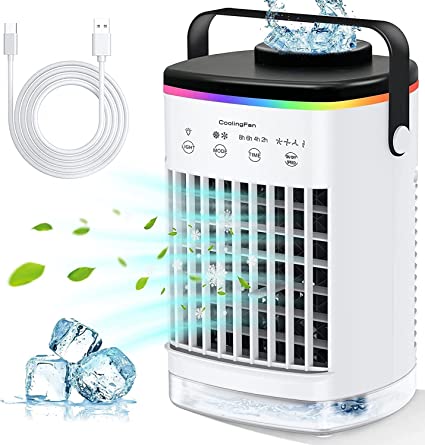
Equipped with a high-performance motor and unique air-duct, this portable air conditioner offers efficient cooling and atomization. It features two mist humidification holes, reducing surrounding temperature by up to 45-50℉ in just two seconds, providing you with a powerful, refreshing airflow. For an enhanced cold breeze, you can add cold water or ice cubes to the unit. Its compact and handheld design is perfect for use at home, in the office, outdoors, or while camping.
This device offers four modes (Natural Wind/Low Cool Mist/High Cool Mist) and four wind speeds (Low/Natural/Mid/High) with 120° up and down wind direction adjustment, providing numerous cooling options. It is powered via a USB charging port and can be used with a power bank, laptop, adapter, mobile power sources, computers, and vehicle chargers. Note that no adapter is included, and a 5V 1.5A USB adapter is recommended.
With a 700ml sealed water tank, this personal air conditioner can operate for 8-10 hours when full, reducing the need for frequent water refills. If the water runs out, it switches to natural wind mode for safety, making it ideal for overnight use. The water level perspective window allows for easy water level monitoring and control, and the top-mounted water tank design adds convenience and prevents leakage.
TIOKVIOP evaporative portable air cooler
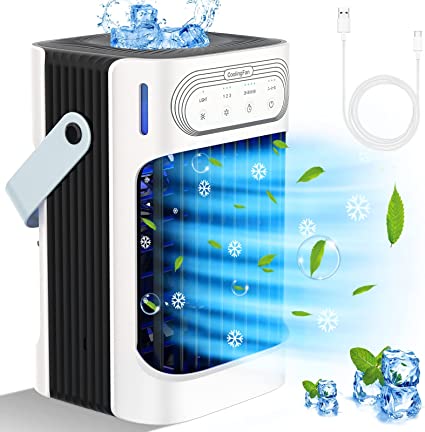
The advanced honeycomb waterfall system of this device cools down the surrounding air to 45-50℉ instantly, offering a refreshing breeze. In contrast to traditional air conditioners, this air cooler mimics natural wind, eliminating dry heat, and creating a moist, cool airflow. It operates as a fan, humidifier, and night light.
The device offers three speed modes and three wind modes, along with dual ultrasonic atomizers and wet triple refrigeration technology. The shutters are adjustable by 120° to direct airflow.
It has multiple power supply modes with a 1.5M cord and USB port, compatible with various devices. There’s also a 2-4-6-8H timer for convenience. With a 10W power rating and 900ml water tank, it provides powerful wind while saving energy, lasting up to 8 hours.
The device features a 7-color built-in night light and is lightweight (900g), making it ideal for various environments including offices, bedrooms, living rooms, kitchens, and camping trips. The product also comes with a lifetime warranty.
How do portable air conditioners work?
Portable air conditioners work on the same basic principles as standard window or central air conditioners: they cool rooms by removing heat from the air and emitting it outside. Here’s a step-by-step breakdown of how they function:
- Air Intake: Portable air conditioners pull in warm air from the room.
- Cooling and Moisture Removal: This warm air is cooled down as it passes over a cooling coil inside the unit. As the air is cooled, its humidity (moisture) condenses on this coil and is collected in a tray or is evaporated out via an exhaust hose.
- Exhaust: The cooled air is then circulated back into the room while the heat absorbed from the air is vented outside through an exhaust hose. This hose typically runs through a window, a wall, or a drop ceiling.
- Refrigeration Cycle: The cooling coil uses a refrigeration cycle, which involves a refrigerant—a chemical compound that easily transitions from gas to liquid. This cycle consists of four main stages: evaporation, compression, condensation, and expansion. The refrigerant evaporates in the evaporator coil, absorbing heat in the process. It’s then compressed into a hot, high-pressure gas, and passed through the condenser coil where it loses heat and turns back into a liquid. Finally, it goes through an expansion valve, drops in pressure, and goes back into the evaporator coil to start the process again.
- Temperature Control: Portable air conditioners have thermostats that allow you to set your desired room temperature. When the room reaches the set temperature, the air conditioner will cycle on and off to maintain it.
Portable air conditioners for rvs
If you spend a lot of time on the road in your RV, a portable air conditioner can be an excellent way to keep your space cool and comfortable, especially during the hot summer months. Here are some things to consider when choosing a portable air conditioner for an RV:
1. BTU Rating: This is the unit’s cooling capacity. The higher the BTU (British Thermal Units), the larger the space the air conditioner can cool. A typical range is between 5,000 to 15,000 BTUs. To choose the right BTU rating for your needs, consider the size of your RV and how hot it gets.
2. Size and Portability: Remember that space is a premium in an RV, so you’ll want an air conditioner that’s compact and easy to move around. Some models come with casters or handles for easier maneuvering.
3. Energy Efficiency: Energy efficiency is especially important in an RV, where power resources might be limited. Look for models with a high Energy Efficiency Ratio (EER).
4. Noise Level: Since you’ll likely be using the air conditioner while you’re sleeping or relaxing, it’s essential to consider how much noise it makes.
5. Ventilation: Portable air conditioners need to vent hot air outside, so ensure you have a suitable place to vent the unit. Most commonly, this is done through a window, but in an RV, you might need to get creative.
6. Additional Features: Some portable air conditioners also function as dehumidifiers, fans, or heaters, providing you with additional value.
A few models that are often recommended for RV use include:
- Honeywell Compact Portable Air Conditioner: This is a compact and efficient model that also includes a dehumidifier.
- Black+Decker BPACT08WT Portable Air Conditioner: This is a popular, highly-rated model that offers strong performance and quiet operation.
- SereneLife SLPAC10 Portable Air Conditioner: This model is easy to install and offers additional features like a built-in dehumidifier and fan modes.
Advantages of using portable air conditioners
Portable air conditioners offer several advantages regarding temperature control in tents. These compact and versatile units are designed to provide efficient cooling in various environments. Here are some key advantages of using portable air conditioners:
Flexibility and portability:
One of the primary benefits of portable air conditioners is their mobility. They are designed to be lightweight and compact, making them easy to transport and install in different tents or camping setups. You can move the unit around within the tent or even take it to different camping locations, providing cooling wherever you go.
Efficient cooling:
Portable air conditioners are specifically engineered to effectively cool small to medium-sized spaces. They have cooling capacities and BTU ratings suitable for tents, ensuring that you can maintain a comfortable temperature inside regardless of the external weather conditions. They are designed to provide targeted and rapid cooling, helping quickly combat heat buildup inside the tent.
Customizable settings:
Many portable air conditioners offer adjustable settings, allowing you to customize the temperature, fan speed, and cooling mode according to your preferences. This level of control enables you to create the ideal climate inside the tent based on the ambient conditions and personal comfort levels.
Improved air circulation:
Besides cooling, portable air conditioners provide enhanced air circulation. They typically feature built-in fans that help to distribute cool air evenly throughout the tent; This helps to alleviate hotspots and maintain a consistent temperature across the entire space, ensuring a more comfortable environment for camping.
Ease of installation:
Portable air conditioners are designed for easy installation and setup. They usually come with clear instructions and require minimal assembly. Most models are compatible with standard tent openings or come with adaptable venting options, allowing for a hassle-free installation without any permanent modifications to the tent structure.
Energy efficiency:
Portable air conditioners are designed to be energy-efficient, helping to minimize power consumption while providing effective cooling. Many models come with energy-saving features such as programmable timers and sleep modes, allowing you to optimize energy usage and reduce costs during your camping trip.
Multi-functionality:
Some portable air conditioners offer additional functionalities beyond cooling. They may include features such as dehumidification or air purification, helping to improve air quality inside the tent; This can be particularly beneficial in humid climates or areas with poor air conditions.
Quiet operation:
Portable air conditioners are engineered to operate quietly, ensuring a peaceful and undisturbed camping experience. The noise levels are typically low, allowing you to sleep or relax without being disturbed by the unit’s operation.
Features and specifications of portable air conditioners
Cooling capacity and BTU ratings:
Portable air conditioners are available in various cooling capacities measured in British Thermal Units (BTUs). Understanding the cooling capacity and BTU ratings is crucial for selecting an air conditioner that can effectively cool your space. Here are some key points to consider:
Definition and importance of cooling capacity and BTU ratings:
- Cooling capacity refers to the amount of heat a portable air conditioner can remove from a room in a given time.
- BTU rating indicates the cooling power of an air conditioner, with higher BTU ratings indicating greater cooling capacity.
Choosing the appropriate BTU rating for your needs:
- Assess the size of the area you want to cool. Larger spaces require air conditioners with higher BTU ratings.
- Consider other factors like room insulation, ceiling height, and sunlight exposure, as they can affect the cooling requirements.
Factors influencing cooling capacity:
- Room size: Larger rooms or tents require air conditioners with higher BTU ratings to cool the space effectively.
- Insulation: Well-insulated spaces retain cool air better and may require less cooling capacity than poorly insulated areas.
- Sunlight and heat sources: Rooms exposed to direct sunlight or with heat-generating appliances may require higher cooling capacity.
Recommended BTU range for different tent sizes:
- Smaller tents (up to 100 sq. ft.): Portable air conditioners with BTU ratings between 5,000 and 8,000 BTUs are suitable.
- Medium-sized tents (100-300 sq. ft.): Opt for units with BTU ratings ranging from 8,000 to 14,000 BTUs.
- Larger tents (over 300 sq. ft.): Consider air conditioners with BTU ratings above 14,000 BTUs for efficient cooling.
Energy efficiency and power consumption:
When selecting a portable air conditioner for your tent, it’s essential to consider its energy efficiency and power consumption. Here are some key points to understand:
Energy efficiency ratings and their significance:
- Energy efficiency ratings, such as SEER (Seasonal Energy Efficiency Ratio) and EER (Energy Efficiency Ratio), indicate how efficiently the air conditioner uses energy.
- Higher SEER or EER ratings signify greater energy efficiency, resulting in lower operating costs and reduced environmental impact.
Calculating energy consumption and cost:
- Understand how energy consumption is measured (typically in kilowatt-hours, kWh) and how it relates to the cost of running the air conditioner.
- Consider the local electricity rates to estimate the potential energy costs of operating the portable air conditioner.
Selecting energy-efficient models:
- Look for portable air conditioners with higher SEER or EER ratings, indicating better energy efficiency.
- Energy Star-certified models meet strict energy efficiency standards and can significantly reduce energy consumption.
Energy-saving features and modes:
- Many portable air conditioners have energy-saving features to optimize efficiency and reduce power consumption.
- Features like programmable timers, sleep modes, and smart sensors help adjust cooling operations based on occupancy and time of day.
Size and portability:
When considering portable air conditioners for tents, evaluating their size and portability features is essential. Here are some key points to understand:
Dimensions and weight considerations:
- Assess the dimensions of the portable air conditioner to ensure it fits well within your tent and doesn’t obstruct movement or access.
- Consider the unit’s weight, especially if you plan to transport it frequently or have limited assistance during setup.
Portability features for easy transportation:
- Look for portable air conditioners with convenient handles or built-in caster wheels for easy maneuverability.
- Units with lightweight and compact designs are typically easier to transport and store.
Compact designs and space-saving options:
- Portable air conditioners come in various designs, including slim and compact models.
- Consider units with a small footprint that occupy minimal space in your tent, allowing for more room and flexibility.
Wheels or handles for maneuverability:
- Portable air conditioners equipped with wheels or handles make moving them within the tent or transporting them to different locations easier.
- Ensure the wheels are sturdy and suitable for different terrain types if you plan to use the air conditioner outdoors.
Noise levels:
When selecting a portable air conditioner for your tent, it’s essential to consider its noise levels to ensure a peaceful and comfortable camping experience. Here are some key points to understand:
Importance of quiet operation in camping environments:
- Camping is often associated with tranquility and a peaceful atmosphere, making low noise levels crucial for undisturbed relaxation.
- Excessive noise from an air conditioner can disrupt sleep, conversations, and the overall camping experience.
Decibel (dB) ratings and noise level explanations:
- Noise levels are measured in decibels (dB), with lower dB ratings indicating quieter operation.
- Understanding the dB scale helps determine the noise level tolerance and choose a unit that meets your requirements.
Quieter models for minimal disturbance:
- Look for portable air conditioners specifically designed to operate quietly.
- Some manufacturers offer models with noise reduction technologies or design elements that minimize operational noise.
Noise reduction features and technologies:
- Explore the noise reduction features and technologies employed in portable air conditioners.
- Examples include sound-dampening insulation, vibration isolation, and innovative compressor designs to reduce operational noise.
Ventilation and exhaust options:
Proper Ventilation and exhaust are essential aspects to consider when using a portable air conditioner in a tent. Here are some key points to understand:
Venting requirements for proper operation:
- Portable air conditioners generate hot air during the cooling process, which needs to be vented outside the tent for efficient operation.
- Adequate Ventilation ensures the unit can expel hot air effectively, preventing heat accumulation inside the tent.
Single-hose vs. dual-hose systems:
- Portable air conditioners come in two primary venting configurations: single-hose and dual-hose systems.
- Single-hose systems use a single vent for exhaust and intake, while dual-hose systems have separate vents.
Window kits or venting accessories:
- Window kits or venting accessories are commonly used with portable air conditioners to facilitate proper exhaust.
- These kits typically include adjustable panels or adapters that fit into the window opening, allowing the exhaust hose to be securely vented outside.
Ventilation considerations for different tent structures:
- Different tent structures may require specific ventilation setups to accommodate the portable air conditioner.
- Consider factors such as tent materials, openings, and available mounting options when planning the Ventilation and exhaust setup.
Additional features
Portable air conditioners often come with additional features that enhance their functionality and user experience. Here are some key features to consider:
Programmable settings:
- Programmable settings allow you to set specific temperatures, fan speeds, or operating modes in advance.
- You can schedule the air conditioner to turn on or off at specific times, ensuring optimal comfort and energy efficiency.
Remote control functionality:
- Many portable air conditioners come with remote control for convenient operation from a distance.
- The remote control allows you to adjust settings, change modes, and control the unit without approaching it physically.
Digital displays and user-friendly interfaces:
- Clear digital displays provide real-time temperature, settings, and operational status information.
- User-friendly interfaces make it easy to navigate through various options and adjust the air conditioner according to your preferences.
Dehumidification and air purification features:
- Some portable air conditioners include built-in dehumidification functions to remove excess moisture from the air.
- Air purification features like filters or ionizers help improve indoor air quality by capturing dust, allergens, and pollutants.
Filter replacement indicators and maintenance reminders:
- Portable air conditioners with filter replacement indicators notify you when it’s time to clean or replace the filters.
- Maintenance reminders can prompt you to perform regular maintenance tasks to ensure optimal performance and longevity of the unit.
Sleep mode and quiet operation settings:
- Sleep mode adjusts the air conditioner’s settings for quieter operation during nighttime, ensuring a peaceful sleep environment.
- Quiet operation settings reduce fan speed and operational noise for a more comfortable and undisturbed experience.
Self-evaporation or auto-drainage systems:
- Some portable air conditioners feature self-evaporation or auto-drainage systems that minimize the need for manual drainage or emptying of condensate.
Choosing the right portable air conditioner for your tent
Tent size and occupancy:
When selecting a portable air conditioner for your tent, it’s essential to consider the size of your tent and the number of occupants. Larger tents or tents with more people will require an air conditioner with higher cooling capacity to ensure effective temperature control and comfort for everyone inside.
Climate and temperature conditions:
The climate and temperature conditions of your camping location play a significant role in choosing the right portable air conditioner. Consider the area’s average temperature, humidity levels, and weather patterns. If camping in hot and humid environments, you’ll need an air conditioner with adequate cooling power and dehumidification capabilities.
Power source availability:
Assess the power source availability at your campsite to ensure compatibility with the portable air conditioner. Determine whether electrical outlets are accessible or if you’ll rely on alternative power sources like generators or batteries. Choose an air conditioner powered by the available sources to avoid any inconvenience during your camping trip.
Budget considerations:
Set a budget for your portable air conditioner purchase and consider the value it provides. Compare prices, features, and performance of different models to find a balance between affordability and quality. Remember that higher-priced units may offer advanced features and greater energy efficiency. Still, choosing one that fits your budget constraints is essential.
Evaluating customer reviews and ratings:
Before making a final decision, it’s beneficial to read customer reviews and ratings of portable air conditioner models. These reviews provide insights into users’ real-world experiences, helping you understand the pros and cons of each model. Pay attention to factors like performance, durability, ease of use, and customer satisfaction to make an informed choice.
Comparing different brands and models:
Take the time to compare different brands and models of portable air conditioners. Consider factors such as cooling capacity, energy efficiency, noise levels, warranty, and customer support. Research the reputation of the brands and read expert reviews to gain a comprehensive understanding of the available options. Comparing brands and models lets you find the best fit for your needs and preferences.
Installation and Setup of Portable Air Conditioners
Preparing the tent for installation:
- Begin by ensuring that the tent is clean and free of any debris or obstacles that could interfere with the installation or proper functioning of the portable air conditioner.
- Remove any items that may be in the way, such as camping gear or personal belongings, to create a clear and spacious area for the air conditioner.
Positioning the air conditioner in the tent:
- Place the portable air conditioner in a central location within the tent to ensure even cool air distribution.
- Consider the layout of the tent and the proximity to the sleeping or activity areas to optimize the cooling effect.
- Place the unit on a stable surface, such as a flat section of the tent floor, and ensure it is positioned securely to prevent accidental tipping or movement.
Setting up the ventilation/exhaust system:
- Install the exhaust hose that came with the portable air conditioner. Attach one end of the hose securely to the exhaust outlet on the unit.
- Determine the best route for the hose to exit the tent while maintaining a proper seal, typically through a window, vent, or designated opening.
- Ensure the hose is connected correctly and tightly sealed at both ends to prevent hot air from escaping into the tent.
Connecting to a power source:
- Check the power source available at your campsite. If there is an electrical outlet nearby, you can connect the power cord of the portable air conditioner to it.
- Ensure the power cord is in good condition and free of damage.
- Consider alternative power sources such as generators or portable power stations for campsites without electrical outlets. Ensure you have the appropriate adapters or cables to connect the air conditioner safely and effectively.
Troubleshooting common installation issues:
- If you encounter any issues during the installation process, troubleshoot them accordingly. Some common problems include kinks in the exhaust hose, improper sealing resulting in air leaks, or difficulty establishing a reliable power connection.
- Check for any hose kinks or blockages that could restrict airflow and affect the cooling performance. Straighten out the hose or adjust its position if necessary.
- Ensure that all connections are securely tightened and sealed to prevent air leakage. Use duct tape or other suitable materials if additional sealing is required.
- If experiencing power-related issues, double-check the power source compatibility and connections. Inspect the power cord and look for any signs of damage or wear. Consider consulting the user manual or contacting customer support for further assistance.
Safety Considerations and Best Practices
When using portable air conditioners in tents, it is crucial to prioritize safety to ensure a secure and comfortable camping experience. Paying attention to the following detailed safety considerations and best practices will help maintain a safe environment:
Electrical safety precautions:
- Before connecting the portable air conditioner, thoroughly inspect the electrical outlets and cords for any signs of damage or wear.
- Ensure that the power source available at the campsite is compatible with the voltage requirements of the air conditioner.
- Use grounded outlets and consider employing surge protectors or power strips with built-in circuit breakers to safeguard against electrical issues.
- Avoid running the air conditioner’s power cord under rugs or high-traffic areas to prevent tripping hazards and potential damage.
Fire safety measures:
- Take precautions to keep flammable materials, such as curtains, bedding, and paper products, at a safe distance from the portable air conditioner and its exhaust system.
- Maintain an appropriate separation between the air conditioner and any open flames or heat sources, including campfires or cooking equipment.
- Regularly clean the air filters of the portable air conditioner to prevent dust accumulation, which can restrict airflow and increase the risk of overheating.
Ventilation and air circulation in the tent:
- Ensure proper Ventilation within the tent to facilitate fresh air exchange and avoid a stuffy environment.
- Avoid obstructing or blocking air vents, openings, or windows, as this can impede the air conditioner’s efficiency and airflow.
- Consider utilizing additional fans or strategically opening windows to enhance air movement and promote better circulation within the tent.
Avoiding overuse and excessive energy consumption:
- Use the portable air conditioner judiciously and avoid running it continuously when not required.
- Adjust the temperature settings to a comfortable level without unnecessarily cooling the tent beyond what is necessary.
- Ensure that the tent is sealed correctly to minimize air leakage through doors, windows, or any other openings, as this can lead to energy wastage and reduced cooling efficiency.
Other methods of temperature control in tents
Maintaining a comfortable temperature inside a tent is essential for a pleasant camping experience. Besides using portable air conditioners, several alternative methods can help regulate the temperature effectively. Let’s explore each method in detail:
Natural Ventilation and airflow: Natural Ventilation plays a crucial role in keeping the air inside the tent fresh and cool. Here are some detailed techniques to enhance natural airflow:
- Opt for a tent with mesh panels or windows that can be fully or partially opened to allow fresh air to circulate.
- When setting up the tent, choose a location that benefits from natural wind flow or breeze, such as near a body of water or in an area with open space.
- Consider the orientation of the tent entrance and windows to take advantage of prevailing winds, ensuring maximum airflow inside the tent.
- Utilize any built-in tent vents or awnings to promote cross-ventilation and maintain a comfortable air exchange.
Shade and insulation techniques: Managing sunlight exposure and insulating the tent can significantly impact the internal temperature. Consider the following detailed strategies:
- Position the tent in a shaded area, such as under trees, cliffs, or other natural structures that protect it from direct sunlight.
- Use reflective tarps or covers on the tent roof to deflect sunlight and prevent excessive heat absorption.
- Insulate the tent floor by placing thick rugs or foam mats underneath to minimize heat transfer from the ground.
Cooling accessories (e.g., fans, misters): Additional cooling accessories can provide relief in hot weather conditions. Consider the following detailed options:
- Use portable fans inside the tent to improve air circulation and create a cooling breeze. Battery-powered or rechargeable fans are suitable for areas without access to electricity.
- Misters or personal cooling devices can provide a refreshing water mist, reducing the perceived temperature inside the tent. Use them sparingly to avoid excessive moisture buildup.
Using tent placement strategically: Proper tent placement can significantly impact the internal temperature. Consider the following detailed strategies:
- Select a location that offers natural Shade, such as under a canopy of trees or near tall rocks, to minimize direct exposure to the sun’s rays.
- Avoid setting up the tent in low-lying areas where hot air accumulates. Instead, choose higher ground for better air circulation.
- Take advantage of natural wind patterns by positioning the tent to maximize the airflow through the windows and vents.
Conclusion
Portable air conditioners for tents are a great way to stay cool and comfortable during hot summer nights. When choosing a portable air conditioner for tents, consider the cooling capacity, power source, size and weight, noise level, and price. The top five best portable air conditioners for tents are Zero Breeze Mark 2 Air Conditioner, Black+Decker Portable Air Conditioner, BougeRV Portable Air Conditioner, SereneLife Portable Air Conditioner, and Whynter ARC-122DS Portable Air Conditioner.
Other recommended portable air conditioners for tents include LG LP0817WSR Portable Air Conditioner, Honeywell MO08CESWK Portable Air Conditioner, Frigidaire FGPC1244T1 Portable Air Conditioner, and Whynter ARC-14S Portable Air Conditioner.

